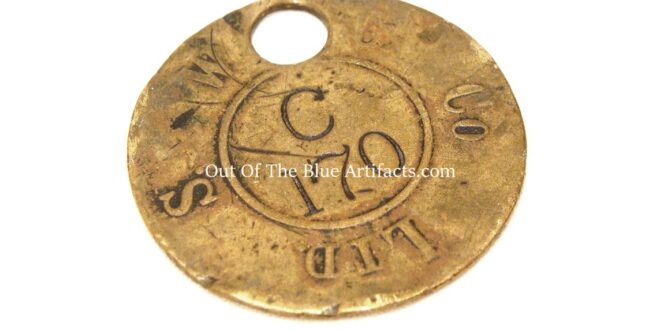The South Wales Colliery Company Ltd – Cwmtillery Colliery Lamp Check 1864 – 1888.
This lamp check was produced by the South Wales Colliery Company abbreviated to S.W.C.Co the same company who owned the Cwmtillery Colliery, Abertillery, it is marked with a capital “C” denoting Cwmtillery Colliery.
Made from brass. Size 1 1/4″ inch diameter.
The Cwmtillery Colliery Story.
Initially Mr Thomas Brown of the Blaina Ironworks established Cwmtillery Colliery and had it sunk in 1842. The colliery was then known as Ty Nicholas or Browns Colliery. In 1847 Mr Brown sold the colliery to his friend Mr John Russell of Risca, in 1864 Mr Russell then gave notice that the colliery, by this time one of the most productive in South Wales was for sale at a price of £66,000. Mr Thomas Brown was eager to buy the colliery back from Mr Russell though the cost was too high a price to pay. Mr Brown approached Mr Crawshay Bailey and persuaded him to establish a company, organise shares in such company and secure the colliery for themselves. In 1864 Mr Bailey did as suggested and formed the South Wales Colliery Company, they purchased the Cwmtillery Colliery from Mr Russell at an undisclosed amount and the rest is history.
The South Wales Colliery Company.
Set up in 1864. The original company consisted of the following –
The Directors – Mr S. P. Vereker (South Staffordshire Railway Co); Mr W. Challis Esq; Mr Thomas Greatrex (Newport); Mr W. B. Greenfield Esq (Pernambuco Railway Co) and Mr Lawrence Heyworth Esq (Yew Tree, Liverpool):
The Chairman – Crawshay Bailey Esq, MP:
Vice Chairman – R. W. Kennard, Messrs Kennard & Co:
Bankers – The Consolidated Bank (Fenchurch St); Messrs Crawshay Bailey & Co (Newport):
Solicitors – George Rooper Esq (Lincolns Inn Fields):
Brokers – Messrs Joshua Hutchinson & Sons:
Auditors – Edward Cheshire Esq (Bank Of Egypt) and Mr Cornelius Walford Esq (Enfield):
Secretary – James J. Wallis Esq:
Offices – No 16 Cannon Street London:
These checks were used until Messrs Lancaster & Spier took control of the both collieries in 1888, briefly, a short while later Messrs J. Lancaster took control from Lancaster & Spier. After nationalisation in 1947 the N.C.B. issued their own lamp checks. These checks were square with rounded corners. In the mid 1970’s man-power lamp checks were introduced into all collieries, these man-power checks were smaller, rectangular or oval shaped.
Points of Interest – The South Wales Colliery Company was a totally different company to the London and South Wales Colliery Company that operated at Risca.
 Out Of The Blue Artifacts A Library of a lifetime of collecting
Out Of The Blue Artifacts A Library of a lifetime of collecting
